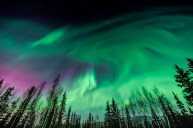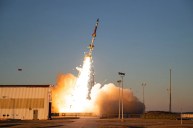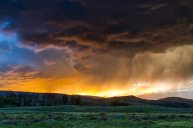The National Weather Service issued a warning that a severe geomagnetic storm set to hit on Friday could have interesting and adverse effects on the Earth. The space weather conditions could supercharge the northern lights so they can be seen in areas they aren't normally seen, and cause disruptions in satellite navigation, communication tools, and power grids.
According to an announcement from the National Oceanic and Atmospheric Administration's Space Weather Prediction Center, the cause of the severe activity is a "large, complex sunspot cluster that is 16 times the diameter of Earth," the agency said. The activity is expected to begin mid-day Friday, May 10, and continue through Sunday, May 12.

A map showing the predicted spread of the northern lights on May 10, 2024. Credit: NOAA
Although three geomagnetic storms have hit so far this solar cycle (since 2019), the agency said that this is the first such warning since January 2005 and the last extreme event to occur was around Halloween in 2003. When that last one hit, it caused power outages in Sweden and damaged power transformers in South Africa.
According to reports, the solar storm is expected to supercharge the northern lights — or aurora borealis — so you will be able to see them in areas ranging from northern California to Alabama.
Rob Steenburgh, a NOAA space scientist, told reporters Friday morning: "If you happen to be in an area where it's dark and cloud free and relatively unpolluted by light, you may get to see a fairly impressive aurora display, and that's really the gift from space weather, is the aurora."




